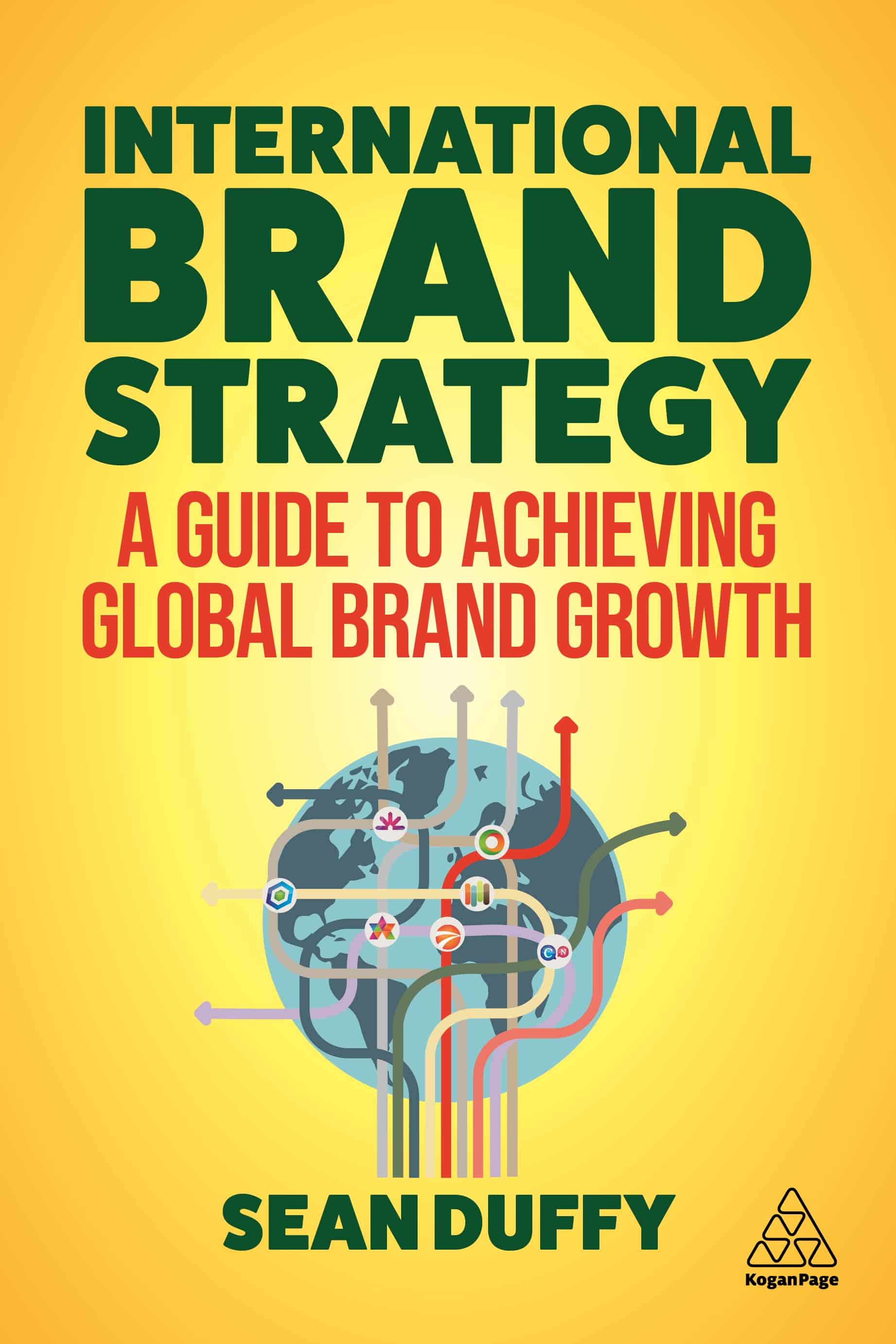There is a lot you can say about your brand. However, only one thing can be said first. That one thing should be your value proposition. It should swiftly identify the problem your brand is focused on and how it’s solved. Your solution doesn’t necessarily need to be unique, but it should be something that is highly relevant to your target and that you are uniquely qualified to deliver on. This should be something that earns you a spot on the prospect’s short list. It also defines your brand’s priority in serving the market. If you can convince the public that you deliver on this promise, it has a halo effect on all other claims.
For instance, Volvo chose safety as its value proposition and dedicated resources to ensure it maintained leadership in that aspect, which gave credibility to its other claims. No one buys a car for safety alone, nor is Volvo the only safe car, but this proposition gave something relevant for Volvo to be remembered by.
| VALUE PROPOSITION BASICS | |
|---|---|
| Objective | Highlights the one or two most enduring attributes the brand stands for and chooses one to lead with. |
| Question | Answers the prospect’s question, “Why should I care about your brand?” |
| Result | Gets you on your ideal prospect’s short list by promising to deliver on one or two critical value requirements better than any other brand in your category. |
| International | Strive for one value proposition you can “own” and be identified with globally without exception. |
| Top Tip | Since it is a reflection of the higher aspirations of the brand, it should also help employees prioritize how they develop the product. |
Value propositions can promise a functional benefit (what it does for your prospect), an emotional benefit (how it makes them feel), or a self-expression benefit (what it makes others feel about them). In fact, there are as many types of value propositions as there are consumer needs. On a cold call, it would be the one thing you say about your offer that keeps your prospects from hanging up. On your website, it should occupy the hero space on the landing page. It should pique people’s interest because it is highly relevant and under-addressed in the category.
Your target has value requirements. These are the things they demand from the solution they seek. You can be identical to your competitors in every value aspect, but in order to compete, you must excel in at least one dimension of value that the target seeks. The value requirement(s) where you do (or could) outperform your competitors is where to start looking for your value proposition. It doesn’t necessarily need to be unique, is probably not a priority for everyone, and may not always be rational, even in B-to-B purchases. But, your organization will have to be able to get behind it and work at developing your superiority in that area. Ideally, you’ll choose an aspect of value that would be difficult or unlikely for competitors to copy too readily.
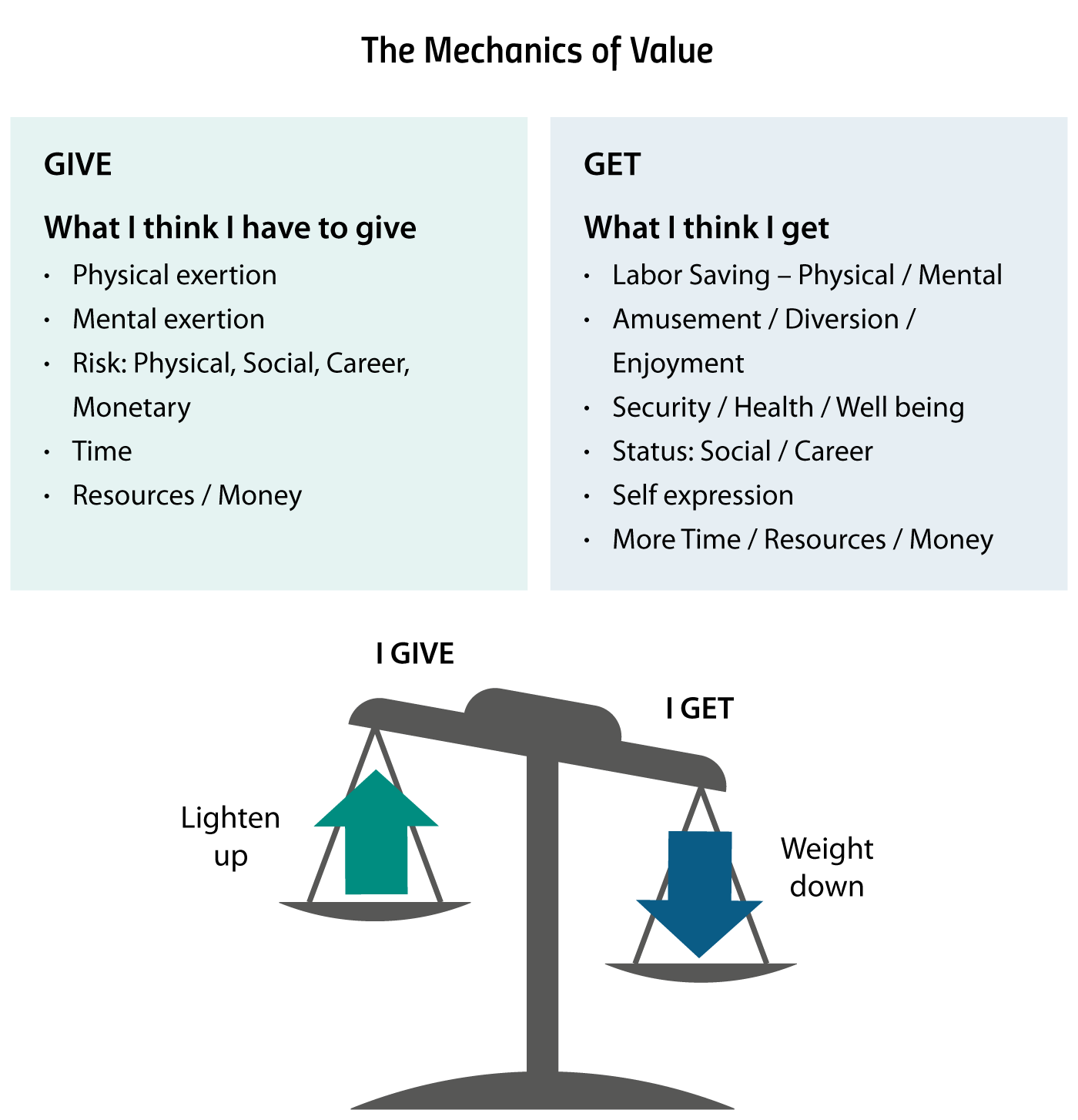
Understading value and value proposition
Most people think of the price tag when they hear value. But, value is not a number so much as it a ratio. It can be helpful to think of it as a mental scale used by consumers where “What I get” — “What I give” = Value. The brand that tilts the scale the most to the right wins. That can be done by lightening up the “give” side and/or weighing down the “get” side. But, in any case, the price tag is just one of several factors that can be used to increase perceived value.
In this equation, “ What I get” is evaluated in relation to the specific need the prospect has and its priority. For instance, if an individual’s real motivation for buying a new watch is status, then they are likely to weigh the brand name more than specific features. “What I give” is evaluated in terms of the prospect’s resources or tolerances. For example, a well-paid but time-starved executive may weigh the time required to purchase the product much more than the price tag.
The value proposition highlights what has been done to tip these mental scales in your favor by either lightening up the “give” side of the equation or weighing down the “get” side. It is based on perceptions, not absolute truth. How your prospects value the various get-and-give aspects of your offer will, most definitely, be very different from the way you and your team value them. In fact, in many cases, the target will value things about the product that the marketing team never even considered. Best to check with the target first.
Keep the value proposition specific and non-subjective. Anytime you see words like “best” or “superior” or “effective” or “smart” in a value proposition, you should recognize it as shoddy strategy work. The whole purpose of the value proposition is to define exactly how your offer is best, superior, effective, or smart. Be specific. Stand for something. It doesn’t mean that’s all you offer, but it gets you seen and gives your prospect something that matters to remember you by. Here are a few steps to get you started:
7 steps to discovering your brand’s value proposition
❶ Survey your competitors
Visit the sites of all main competitors. Look at the messaging and reverse engineer what their value proposition is. Write each down, then use your best judgement to prioritize them according to how well established the proposition is among your prospects and customers. Do any competitors own a word or claim in your prospect’s mind? If so, what is it?
❷ Assemble the raw materials
Start with a blank sheet of paper and create a list of all the possible attributes, features, benefits, and other potential selling points for your brand. The only filter to apply at this point is truth: Write down everything that is true, regardless of differentiation, relevance, believability, or sustainability. You should have 25-75 attributes. These are all the things that could be said truthfully on behalf of the brand.
❸ Filter your attributes
Now apply the following filters:
A. Differentiation Filter
- Arrange your list into the following categories:
- Unique — only your brand can claim this
- Differentiating — only a few brands can or do claim this
- Common — many brands claim this
- Hygiene factors — expected for inclusion in the category
Be ruthlessly honest here, especially with regard to the hygiene factors posing as selling points. Hygiene factors are attributes that are essential to the prospect, but, at the same time, are fairly standard for the category and therefore expected and not noteworthy, e.g. “Our laptop computer comes witha power cord.” Since people expect to get a power cord with their laptop, it is already communicated by the category. Mentioning this in promotion near the tip of the wedge is redundant and a waste of your most precious communication real estate. The place for this type of information may be on a spec sheet much further back in the communication wedge.
B. Relevance Filter
Next, take the factors that are unique and differentiating for your brand and order them according to which you feel will be most relevant across all your target segments. Which factors would tip the value scales most in your favor?
C. Believability Filter
In the best case scenario, you’ll be able to vividly demonstrate your value proposition with your own classic like the Krazy Glue hard hat spot, Pepsi Challenge, or Timex’s, “It takes a lickin’ and keeps on tickin’ ” campaigns. In any case, be prepared to support your value proposition and position with evidence. It can be factual (e.g. product features) or circumstantial (e.g. celebrity endorsement), but it has to be believable. And, just because it’s true, it doesn’t mean it’s believable. Cross off any attributes that you feel you can’t support or that simply will not be believed by your target.
D. Sustainability Filter
The last check is for sustainability. There’s nothing wrong with flouting short term advantages while you have them (as long as they have passed through the four filters above). But, be careful about crafting your brand identity around them or becoming too closely associated with them because, if they are short lived, your brand could fade with them. Ideally, your value proposition is crafted around a claim that will maintain its relevance to the target, but also one that you will be able to maintain and defend indefinitely. So, cross off any attributes that are easily copied by competitors or otherwise not sustainable or defendable indefinitely.
New product categories are particularly vulnerable in this regard. That‘s because the core benefits of new technologies tend to become hygiene factors as the category begins to mature. Equally challenging are product categories with fast-moving product development cycles, like many medical devices and technology brands. The shelf life of product innovations in these categories can often be measured in weeks.
❹ Talk to your target
You should now have a list of several attributes that you have filtered and prioritized according to what you think will be most relevant to your target market. You also have a list of what your competitors claim to be their main attributes. Time to put both to the test. Have a third party investigate your prospects to:
- Confirm the category and who is perceived as the major players in that category.
- Write a prioritized wish list of the top 10 factors that prospects want from your category.
- Probe to see which factors are felt to be most and least adequately served by their current options.
- Rate how each player in the category performs according to the criteria in the wish list.
- Only after this, show your list of filtered and prioritized attributes and get feedback.
- See which, if any, is most relevant to them and what support would be most convincing.
- Probe to see if there are attributes you have missed.
The mechanics of value propositions
In most mature categories, if you apply three factors to a Venn Diagram 1) What your ideal prospect wants from the category, 2) what your brand does, 3) what your competitor brand does), the picture can look rather bleak. Not much room to stand out. But, if you make a simple modification, you will start to see the opportunities for your brand.
Change your factors to:
- What your ideal prospect REALLY wants from the category,
- What your brand can or does VERY WELL
- What your competitor’s brand does VERY WELL.
This is the diagram to use when trying to find your unique value proposition.
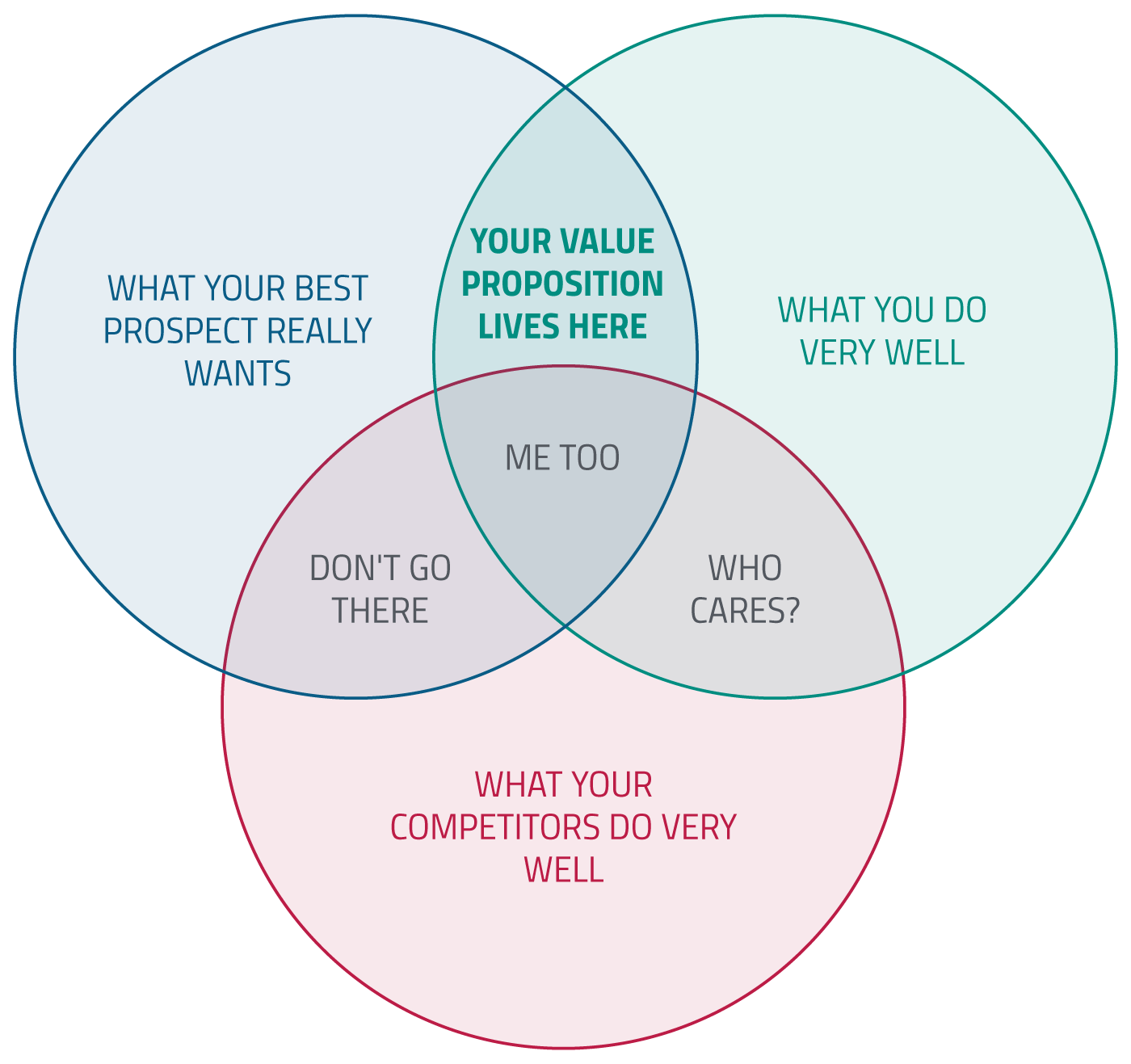
❺ Define your value offer
The results of the target interviews should have narrowed your list right down to what is:
- most relevant to your target; and,
- most credible for you to claim.
Define how your offer delivers value to the prospect in plain terms. Remember this is a strategy statement, not a tagline or headline. Your value proposition statement will never be seen by the outside world. Don’t try to make it fancy,
just extremely clear. You can try a template like the one below, but don’t be restricted by it. Feel free to color outside the lines.
For (your brand’s broad target market) who (statement of main problem your product addresses), (your brand name) excels at (statement of main solution you provide) because (primary support).
❻ Support your value offer
Now list all the proof you have that directly supports your value proposition. Prioritize the points that your target indicated would be most convincing and/or that are most easily demonstrated. Be selective here. It’s better to have three main points that are easy to remember and be known for than to have a bullet-proof list of twenty different support points, of which none will be remembered or associated with your brand. These are the reasons to believe that will be provided to the market.
❼ Communicate your value proposition
Your value proposition should jump off the page when a prospect lands on your corporate site’s homepage or main page of your product. It should be stated clearly and prominently whenever your brand is presented. It should also be reinforced with the type of content published (and avoided) and the topics you choose to focus on and people you engage with in your online networking efforts. It should also be reflected in the way you choose to profile your brand including the causes you support, the events you sponsor, and the spokespeople and brand ambassadors you select. Your dedication to this topic should shine through all your communication.
Value proposition examples
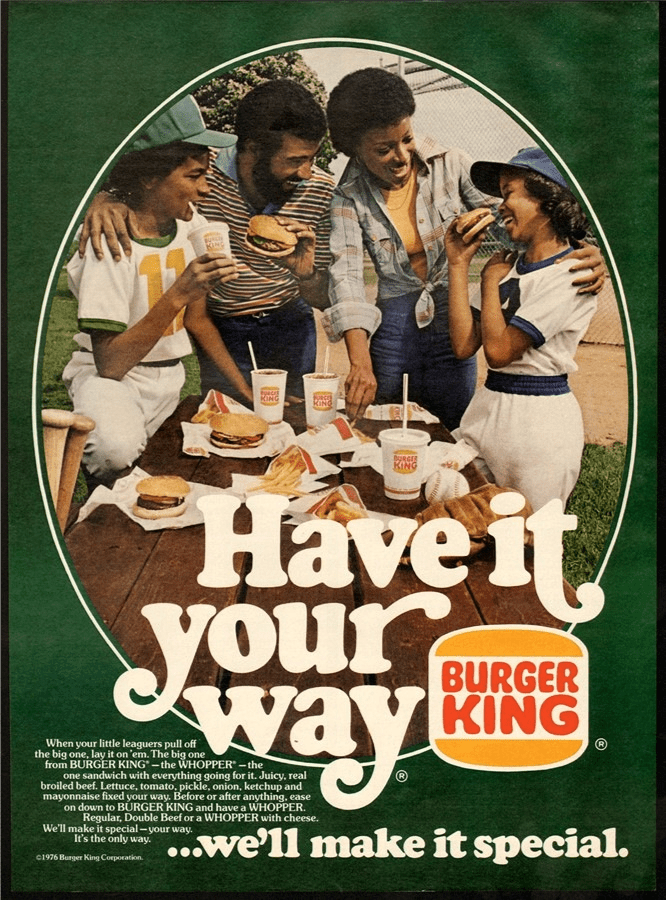
- Burger King
McDonalds launched the fast food category in 1948, when they applied production-line principles to the assembly of hamburgers. One by-product of this efficiency was a certain degree of rigidity. McDonald’s system did not allow for special orders. Rival Burger King also used the assembly line concept, but theirs was slightly different in that it accommodated special orders. Research showed this struck a nerve with Americans. So, in 1974, they adopted a value proposition to leverage against McDonald’s weakness: fast food made to order. This was expressed in the tag line “Have it your way,” which they’ve stuck with for forty years.
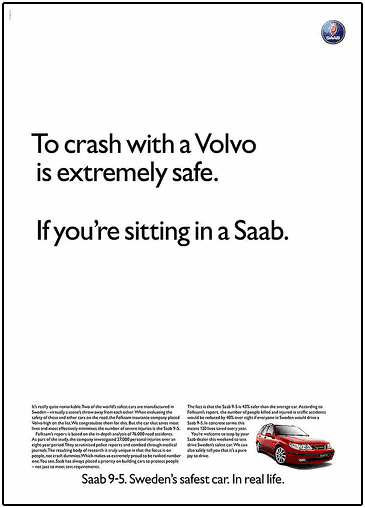
- Saab
For most of its adult life, Saab Automobile was a premium brand in search of a value proposition. The fact that they never found one contributed to the company going out of business in 2011. But, in the late 1990’s, an independent report was published indicating that Saab automobiles were, according to insurance company records, safer than Volvos. The knee-jerk reaction among many on the Saab team was to communicate this point aggressively in an attempt to steal some thunder from Volvo.
Fortunately, cooler heads prevailed and the study was used to support Saab’s safety claims further down the communication wedge, but not as the brand’s main focus. Why? Because at that point Volvo had done such a great job driving home the safety message that Saab claiming to be safer simply wasn’t credible — even if there was a study that said it was true. Unseating a brand’s value proposition can be done, but it’s an expensive proposition if the brand in your crosshairs is as strong as Volvo and your only ammunition is a single study.

- Ericsson Phones
When mobile phones first went mainstream in the 1990’s, the biggest concern was simply being able to make a call because there were so few towers. In response, mobile handset producer Ericsson focused their value proposition on engineering to deliver a reliable signal. That worked well for a few years, but then good reception became a hygiene factor as the category matured. Ericsson didn’t monitor customer preferences effectively and kept focusing their product development and marketing communication efforts on better engineering long after the market had moved on to a new value battleground: Better design. Nokia had anticipated this with a designcentered value proposition and decimated Ericsson’s global leadership in mobile handsets. History would repeat itself in 2007, when the iPhone was introduced with a value proposition built around internet connectivity and software. The public shifted their value requirements in Apple’s favor, but Nokia hadn’t monitored customer preferences effectively and remained focused on conventional telephony attributes. Nokia was left in the dust.
Checklist: Value Proposition
- Is your value proposition focused on a specific problem?
- Does your value proposition offer a specific solution?
- Does your value proposition imply a specific target?
- Is the problem you claim to solve felt acutely by your target?
- Is your value proposition free of superlatives, like best, smart, superior, etc.?
- Have you verified your value assumptions with your target market?
- Does your value proposition work globally?
- Is your value proposition true, relevant, differentiating, believable, and sustainable?
- Does it address a need that the target perceives to be underserved in the category?
- Have you defined your proposition in plain terms that non-experts could understand?
- Can you support your value proposition convincingly?
- Is your value proposition unavoidable on your brand’s main landing page?


